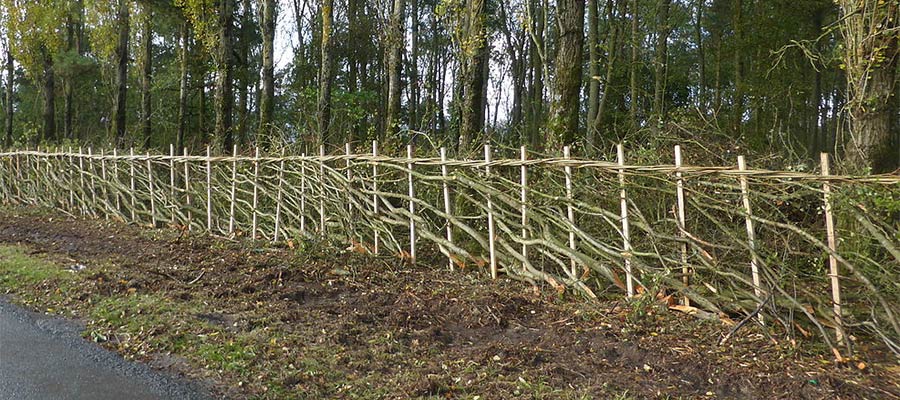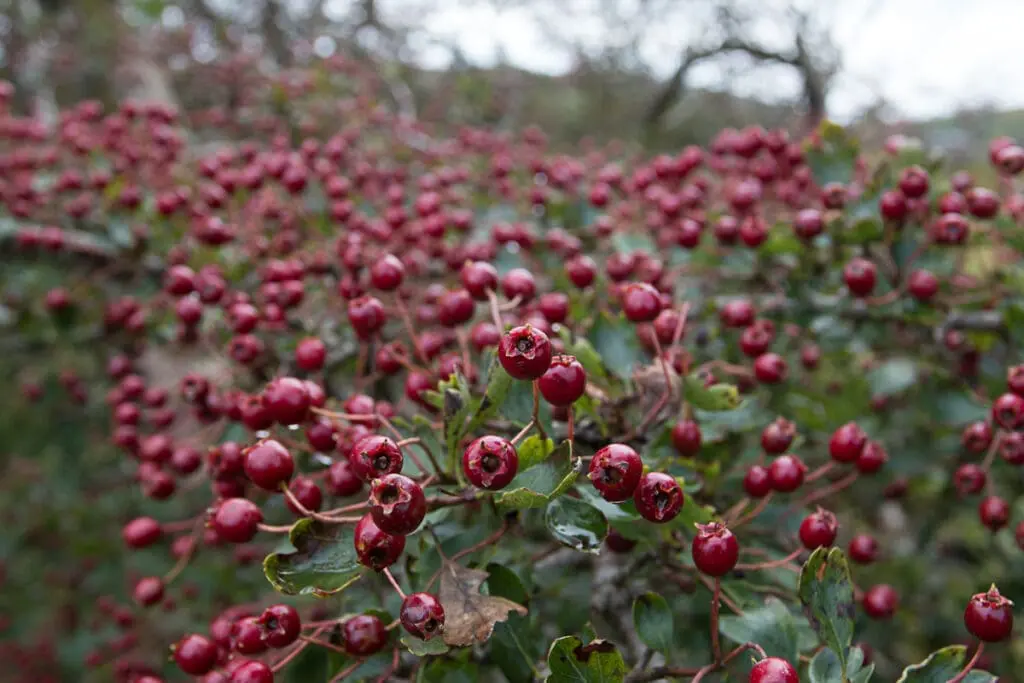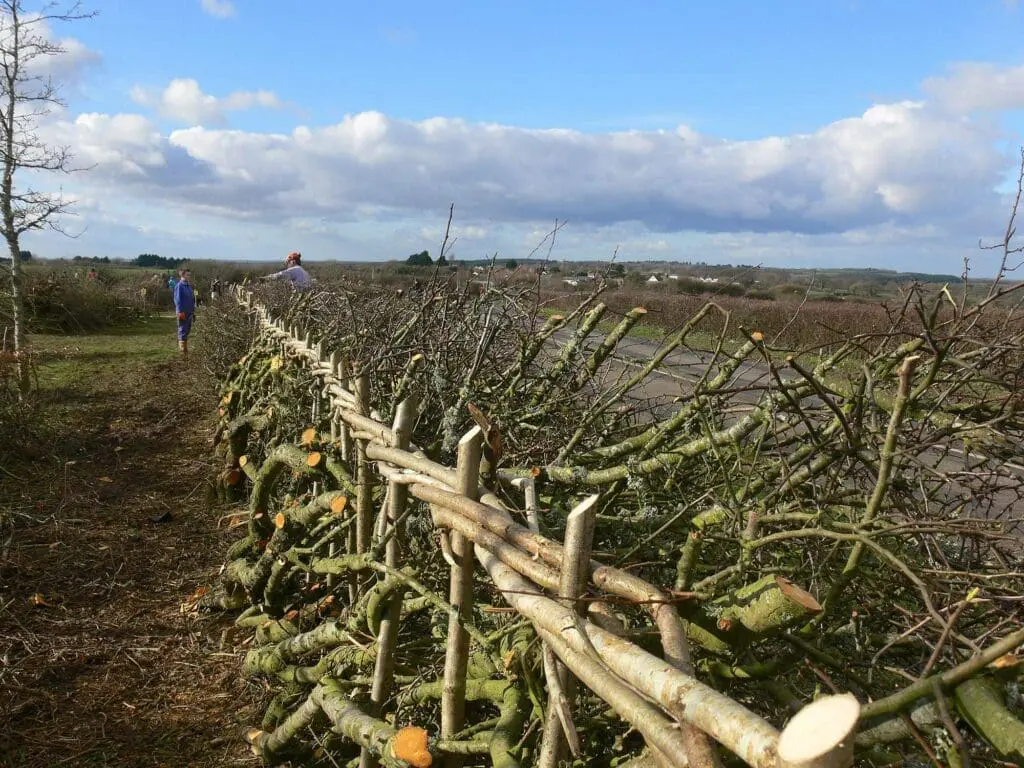In the post-1945 period of agricultural expansion, many thousands of miles of hedgerow were destroyed to enlarge fields, and for building development. The rate of destruction has now slowed, and between 1990 and 1993 the length of new hedges being planted outstripped that being removed. The Hedgerow Regulations of 1997 have provided some protection for hedgerows.
Neglect remains a major threat to hedgerows. Frequent cutting and use of herbicides can reduce a hedge to a line of stunted, bare-stemmed bushes. Laying rejuvenates a hedge by encouraging new growth from the base. In this linear thicket other plants and animals can flourish, producing a feature which is valuable for wildlife, functional for farming and enhances the landscape.
Hedge loss
Hedges have been lost to housing, industrial developments and road building, but the overwhelming reason for hedgerow loss is changing farming methods. Small fields were amalgamated into much larger units to accommodate increased mechanisation. Intensification and the shift away from mixed farming – which requires stock proof barriers – to permanent arable rotations are largely to blame. From some farmers point of view, hedges make it difficult to use large machines, are an unprofitable use of space and harbour weeds and vermin. However, some farmers do retain hedges but many trim them mechanically which causes deterioration and leaves gappy hedges after a few years.
Traditional boundaries
Fields and field boundaries have been part of our landscape since civilisation began, with clearance of the wildwood that covered most of the country.
‘Dead hedges’ – cut coppice material woven between stakes and supplemented with faggots of thorn and bramble to form a continuous hurdle-type barrier – were often still used in medieval times. However remains of living hedges have been dated back to Roman times and probably existed in earlier times as the remnants of the cleared forest. Hedge planting peaked between 1750 and 1850 when hedges were planted at an average rate of 2,000 miles a year.
Hedges were formed in one of three main ways. They were sometimes remnants of cleared woodland, left as a dividing strip. Natural regeneration also produced hedges, either at times of low agricultural activity such as during the Black Death, or when they were protected from grazing animals by dead hedges.
The other way was by actual planting. Seedlings were gathered from local woodland and waste land, and acorns and other seeds were pushed into the banks.
Why hedges need managing
Although the cutting and laying of stems or pleachers to form a living barrier was known to the Romans, early hedge management was probably by coppicing or cutting the hedge to the ground. Early hedges, which are usually on a single or double bank, were probably very rough and wide and allowed to grow high before being cut to provide a valuable source of timber and firewood. Regrowth was protected by moving over to arable cropping until the hedge was sufficiently thick and established to withstand grazing again.
The most common form of modern hedge management today, is an annual short back and sides with a tractor and flail. This is a relatively cheap option and keeps the hedges looking neat which many landowners feel reflects a well-managed enterprise. In the early years of mechanical trimming the repeated cutting promotes a dense interlocking of branches and twigs.
However, eventually the bottom and inner branches die back leading to gaps at the base and in the middle of the hedge. Within 20 years the hedge can cease to be stock-proof and will support less wildlife.
But if the hedge is laid every 10-20 years, it can remain vigorous and stock-proof indefinitely. Only a portion of the hedge system needs to be managed each year, saplings can be singled out for hedgerow trees and a significant amount of firewood can be cropped each year.
New shoots tend not to grow from the cut surface but from a point a little below. This is because the wood on the surface is killed by frost and water penetration. However, blackthorn, a common hedge species, regrows from roots at the side of the cut stump.
As long as the hinge left contains some sapwood, bast and cambium – it will live.
Ancient skills
The traditional labourers winter job of hedgelaying is carried out on few farms today, as economic pressures, cheap post and wire fencing and fewer farm workers have contributed to the inadequate management of our remaining hedges. The opportunity exists for trained conservation volunteers to help the landowner rediscover the craft and its value in rejuvenating hedgerows.
Hedgelaying costs more than annual trimming but may attract grants through Countryside Stewardship, Woodland Trust and others.
Regional styles developed, reflecting different techniqes and species used. The most common is the Midland hedge, designed as a bullock barrier. Welsh hedges tend to be denser at the base and are used to contain sheep. Every county once had its own type of billhook, an essential hedger’s tool, but many have disappeared from use, leaving a few types which are still available.
Hedgerow wildlife facts
As the UK’s forests disappeared, woodland flora and fauna found a haven in hedgerows, which mimic the woodland edge. Protecting this biodiversity is the main reason for hedge conservation. However, it is important to realise that tall overgrown hedges are the best for wildlife. Managing hedges by laying and trimming is better than no hedge at all and it prolongs the life of the hedge, which is good for the species that live there.
- A tall thick hedge with good bottom growth is of more value to wildlife than a low thin hedge.
- The hedgerow habitat is varied, freshwater species live in ditches and there’s often rough grassland on the banks.
- Hedges offer wildlife a surprisingly large habitat. One hectare of land is lost to agricultural production for every six kilometres of hedge.
- Almost 1,000 native plant species have been recorded in our hedges and verges. Common hedge shrubs and trees include hawthorn, blackthorn, hazel, oak and ash and plants such as primrose and cow parsley.
- Most of our resident woodland birds breed or feed in hedgerows, such as the dunnock or hedge sparrow, wren and goldfinch. They are joined by summer insect-feeders such as whitethroats and winter berry-foragers such as fieldfare and redwings.
- Hedgehogs, voles, shrews and mice, as well as the rare dormouse, use hedges for shelter and food.
- Frogs, toads and newts can be found in damp hedge bottoms, ditches and ponds. Reptiles such as the slow worm, grass snake and adder can be seen basking on hedge banks or hunting amongst the stems.
- Invertebrates are common in most hedges but thrive on old and overgrown ones. Over a hundred types of moth feed on hawthorn alone, with nearly as many on blackthorn.
- The flowering herbs of the hedge bottom provide nectar and caterpillar food sources for the Gatekeeper (hedge brown, Pyronia tithonus) and brimstone butterflies.



